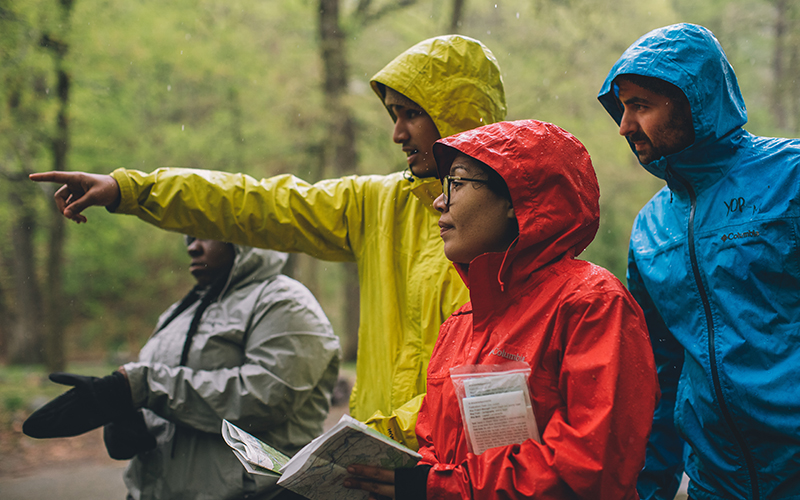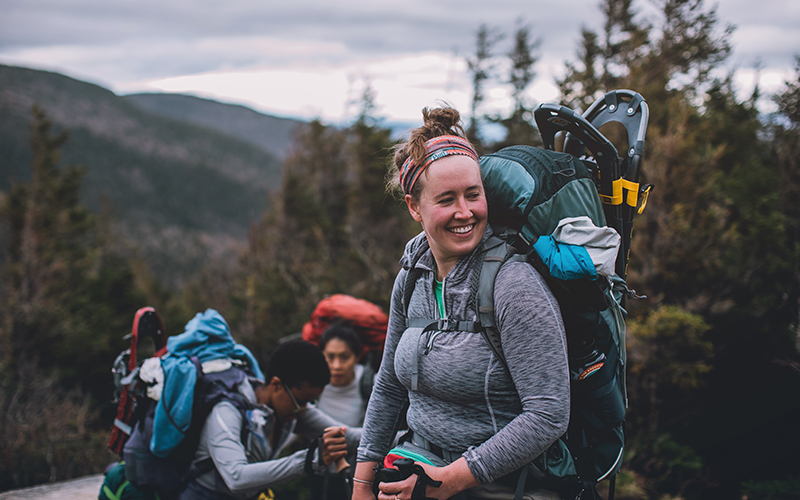
Health and safety go hand in hand with humans’ environmental impact. By planning a trip ahead of time, you consider all the factors that go into its success and identify ways to lessen your impact on the areas you plan to visit.
“The impacts of poor planning can be significant,” says Alex Delucia, Leave No Trace programs manager for AMC. “Improper disposal of human waste and improper food storage can cause wildlife impacts—like disease, wild animals becoming more aggressive as they rely on and seek human food, or damage to fragile plant life—while inadequate gear and clothing could lead to personal emergencies.”
To help trip leaders and individuals prepare for a trip outdoors, AMC provides a number of detailed planning resources. Whether you are traveling with an organized group, with friends, or even by yourself, it’s important to consider the following series of questions to assure you Leave No Trace.
1. What are the goals or expectations of the trip? Whether you hope to summit a mountain or paddle a section of a river, it’s important to set expectations for the group and make sure everyone is on the same page. Spend some time ahead of the trip researching maps and guides so participants know how long the trip will be, what types of terrain they should expect, and what they should look forward to. You should also communicate plans in case of an emergency or bad weather, and have an exit strategy if you need to leave the trail early. Share your travel plans with someone not on the trip, including the route, start time, and expected return time, so they know to call for search and rescue if something goes wrong.
2. What is the skill and ability of trip participants, and does the trip match them? If you’re traveling with a group of beginner hikers, for example, you shouldn’t take the group on a difficult trail. Instead, choose a route that matches everyone’s abilities. This helps keep everyone safe and comfortable and assures a positive experience in the outdoors.
3. Where are you headed and what are the rules? Check the website of the land manager of your destination to learn more about how to behave while recreating there, and write down their contact information in case you need it. If you plan to camp, check to see where you can camp, if you need to reserve a permit, if fires are allowed, if there are parking or access fees, and if bear cannisters are required or if the campsite has food storage containers. These requirements are put in place by the land manager to help keep humans, wildlife, and the land safe.
4. When do you plan to go and will it be crowded? Overuse of trails contributes to erosion and deterioration of plant life. If you plan to visit a crowded trail or park, you may choose to go off-season when there are smaller crowds or during times of the day when trails are quieter, like early morning or evening. You should also consider the season and check the weather regularly ahead of the trip, packing enough gear for whatever conditions you may encounter. If you’re planning to take your trip in winter, you’ll need to factor in colder temperatures, slower travel times, shorter days, heavier gear, and the reduced capacity for emergency response.

5. What gear do you need to be comfortable, safe, and Leave No Trace? Packing the right gear is essential to the safety and success of any trip. AMC’s gear lists are available to the public and cover every season. “All of this better sets you up for success as opposed to finding yourself needing to make decisions that are more impactful or, even worse, finding yourself in trouble and in need of help,” Delucia says.
When it comes to trash, Leave No Trace practices “carry in, carry out,” meaning that whatever you bring into nature should not be left behind. Candy wrappers, apple cores, banana peels, toilet paper, tampons, and anything that doesn’t belong in the wilderness in the first place should be carried out. Meal planning helps prevent unnecessary food waste and keeps packs lighter while helping predict how much trash you may need to carry out. (Pro tip: After eating your sandwich or other trail snack, reuse the plastic storage bag to carry trash out.)
6. Post-trip: What would you do differently next time? Something may go wrong when you are outside, and it’s important to take some time after a trip to evaluate how the trip went and use it to learn for the future. Maybe you underestimated the group’s abilities and now know that they can take on more challenging routes, or maybe you forgot to pack an extra pair of socks and got your feet wet during a stream crossing. Whatever the case, take some time after a trip to evaluate what worked well and what didn’t.